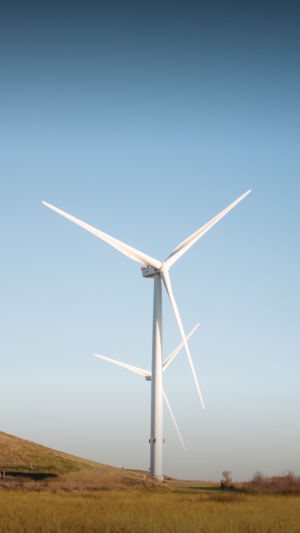Wind turbines have been used as a source of power for centuries, and they have played a crucial role in the development of productivity.
In the early 1970s, the world faced an energy shortage due to the oil crisis, leading to a renewed interest in clean and renewable energy sources such as wind energy. Wind energy is generated by the movement of air over the Earth's surface and is considered a clean, safe, and renewable source of green energy.
The total amount of wind energy in the world is estimated to be around 130 gigawatts, with the majority of resources concentrated in coastal areas and open continents such as the United States and northern Europe. These areas are ideal for wind power generation due to their favorable wind conditions.
Wind turbines have a long history, with the ancient Persians using vertical-axis windmills to grind rice as early as the 2nd century BC. Windmills were introduced to Europe in the 13th century and became an indispensable source of power in the 14th century. In North America, wind turbines were used for irrigation and power generation by the 1720s.
The modern wind turbine was first introduced in 1897 by Danish engineer Poul La Cour. He trial-produced a wind turbine with four blades, paving the way for modern turbines with fewer blades and higher efficiency. Since 1920, people have been studying the use of wind turbines for large-scale power generation.
Wind turbines work by converting wind energy into mechanical work, which drives the rotor to spin and outputs alternating currents. The wind wheel rotates under the influence of the wind, converting its kinetic energy into the mechanical energy of the wind wheel shaft, which then drives the generator to produce electricity.
Wind turbines come in various sizes, from small, individual turbines used for homes and small businesses, to large, commercial-scale turbines used in wind farms. The size of the wind turbine depends on the amount of energy needed and the wind conditions in the area.
There are two main types of wind turbines: horizontal-axis turbines and vertical-axis turbines. Horizontal-axis turbines are the most common type and have blades that rotate around a horizontal axis.
Vertical-axis turbines have blades that rotate around a vertical axis. Both types of turbines have their own advantages and disadvantages, and the choice between them depends on the specific application and the wind conditions in the area.
One of the main advantages of wind energy is that it is a clean and renewable source of energy. Unlike fossil fuels, wind energy does not produce greenhouse gases or other harmful pollutants, making it an environmentally friendly source of energy. Additionally, wind energy is abundant and widely available, making it a cost-effective alternative to traditional energy sources.
Another advantage of wind energy is that it is a reliable source of energy. Unlike solar energy, which is dependent on weather conditions, wind energy is consistently available and can be used to generate electricity even on cloudy days.
Additionally, wind energy is becoming increasingly cost-competitive with traditional energy sources, making it a more attractive option for both consumers and businesses.
However, there are also some disadvantages to wind energy. One of the main challenges is the intermittency of wind, which means that the wind may not always be available when it is needed.
This requires the use of energy storage systems or backup power sources to ensure a consistent supply of energy. Additionally, wind turbines can be visually intrusive and may have an impact on wildlife, such as birds and bats.
Despite these challenges, wind energy is becoming an increasingly important source of energy for the world. With the growing demand for clean and renewable energy, wind energy has the potential to play a significant role in meeting the world's energy needs.
Governments, businesses, and individuals are investing in wind energy technology and infrastructure, and the industry is expected to continue to grow in the coming years.
In conclusion, wind turbines are a crucial source of clean and renewable energy that are becoming increasingly important as the world faces an energy shortage and the need for clean energy sources.
With favorable wind conditions in many areas, wind energy has the potential to play a significant role in meeting the world's energy needs, and the industry is expected to continue to grow in the coming years.





